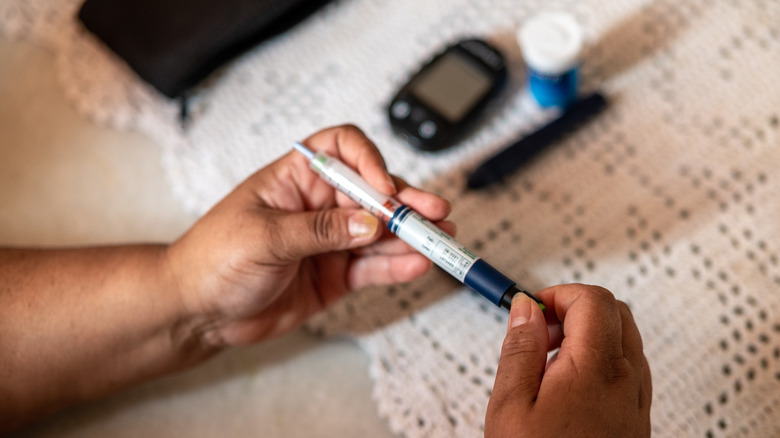The Link Between Excess Weight And Type 2 Diabetes Explained
One out of every 10 people in the United States has diabetes, and most of those people have type 2 diabetes, according to the Centers for Disease Control and Prevention. The CDC also says that more than 40% of people in the United States are considered obese, which is having a body mass index (BMI) higher than 30.
Diabetes is a chronic disease that occurs when the body either doesn't produce enough insulin or doesn't use it properly to process the sugar in the blood. Insulin resistance occurs when the cells in the body become resistant to the effects of insulin, meaning that the body needs to produce more insulin to maintain normal blood sugar levels. High blood sugar can damage the nerves and blood vessels in the heart, feet, hands, kidneys, and eyes. It can also cause nerve damage, kidney failure, vision problems, cardiovascular disease, and depression.
Being overweight — having a BMI of 25 or higher — puts you at higher risk for type 2 diabetes. It's estimated that 90% of people with type 2 diabetes are overweight. The link between excess weight and diabetes is so strong that it's been nicknamed "diabesity," according to the Obesity Action Coalition. Let's take a closer look at how these two conditions are connected.
How fat is linked to insulin resistance
According to a 2014 article in Diabetes, Metabolic Syndrome and Obesity, type 2 diabetes develops when both insulin resistance and inefficient insulin production from the pancreas occur. Although this is most common in those who are overweight or obese, not everyone develops diabetes. Generally, the pancreatic cells that make insulin are able to produce enough insulin to counteract lowered insulin levels, preserving normal glucose levels.
How is this related to fat? Fat tissue will secrete hormones, glycerol, nonesterified fatty acids (NEFA), and other substances. The more fat, the more secretions of these substances. It's believed that it's the NEFAs that affect insulin resistance. The distribution of fat can also affect insulin resistance. If fat is centralized around the chest and abdomen, it's linked to higher insulin resistance.
On the other hand, muscle cells are more receptive to insulin, according to Honor Health. That's why people can decrease insulin resistance just by exercising. Muscles also use excess blood glucose during exercise so the body doesn't need to secrete as much insulin.
Preventing type 2 diabetes
There are some risk factors for type 2 diabetes that you can't control. Some people have a family history of diabetes, and certain populations — such as Asian, Pacific Islander, American Indian, African American, and Hispanic populations — have a higher risk for type 2 diabetes. Older people are also more susceptible to type 2 diabetes because the pancreas becomes less efficient in insulin production as we age.
However, there are some risk factors you can control. According to the Obesity Action Coalition, you're three-to-seven times more likely to develop type 2 diabetes if you are obese. If your BMI is 35 or higher, you're 20 times more likely. You can reduce your risk of type 2 diabetes by making changes to your diet — you can start by trimming between 500 to 1,000 calories a day from your daily food intake. Your macronutrient ratios should be 20% to 35% fat, 45% to 65% carbohydrates, and 10% to 35% protein.
Because exercise can improve insulin sensitivity, aim for 30 to 45 minutes of exercise five days a week. If exercising for that long doesn't seem attainable at first, you can break it up into smaller intervals throughout the day. You can also try to increase the number of steps you take each week to get a little more activity throughout the day.



